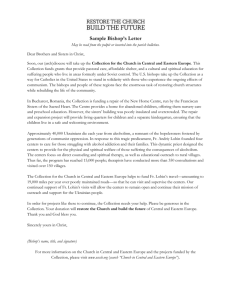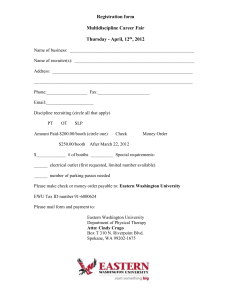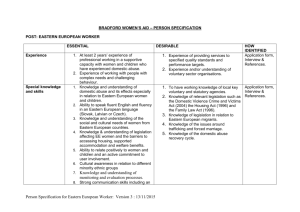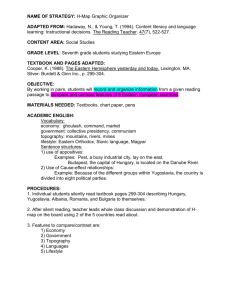frame the lesson
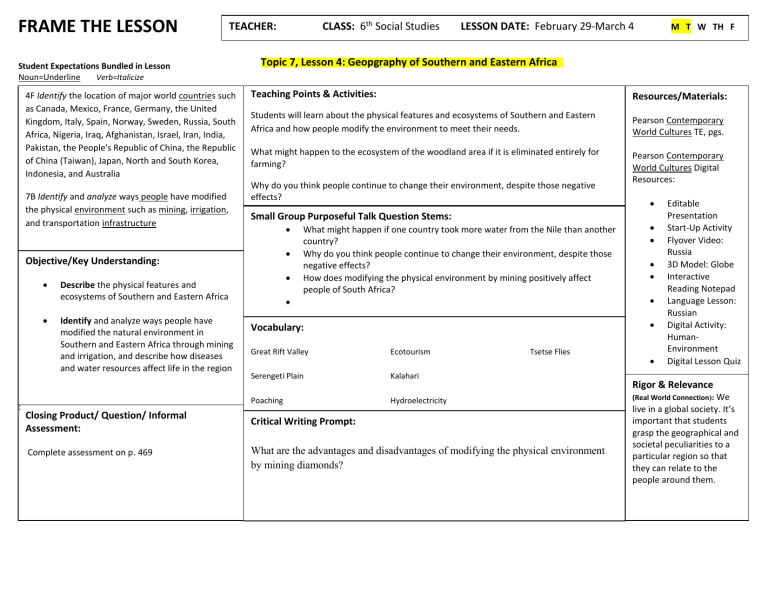
FRAME THE LESSON
TEACHER: CLASS: 6 th Social Studies LESSON DATE: February 29-March 4 M T W TH F
:
Student Expectations Bundled in Lesson
Noun=Underline Verb=Italicize
4F Identify the location of major world countries such as Canada, Mexico, France, Germany, the United
Kingdom, Italy, Spain, Norway, Sweden, Russia, South
Africa, Nigeria, Iraq, Afghanistan, Israel, Iran, India,
Pakistan, the People's Republic of China, the Republic of China (Taiwan), Japan, North and South Korea,
Indonesia, and Australia
7B Identify and analyze ways people have modified the physical environment such as mining, irrigation, and transportation infrastructure
Objective/Key Understanding:
Describe the physical features and ecosystems of Southern and Eastern Africa
Identify and analyze ways people have modified the natural environment in
Southern and Eastern Africa through mining and irrigation, and describe how diseases and water resources affect life in the region
Closing Product/ Question/ Informal
Assessment:
Complete assessment on p. 469
Topic 7, Lesson 4: Geopgraphy of Southern and Eastern Africa
Teaching Points & Activities:
Students will learn about the physical features and ecosystems of Southern and Eastern
Africa and how people modify the environment to meet their needs.
What might happen to the ecosystem of the woodland area if it is eliminated entirely for farming?
Why do you think people continue to change their environment, despite those negative effects?
Small Group Purposeful Talk Question Stems:
What might happen if one country took more water from the Nile than another country?
Why do you think people continue to change their environment, despite those negative effects?
How does modifying the physical environment by mining positively affect people of South Africa?
Vocabulary:
Great Rift Valley
Serengeti Plain
Poaching
Critical Writing Prompt:
by mining diamonds?
Ecotourism
Kalahari
Hydroelectricity
Tsetse Flies
What are the advantages and disadvantages of modifying the physical environment
Resources/Materials:
Pearson Contemporary
World Cultures TE, pgs.
Pearson Contemporary
World Cultures Digital
Resources:
Editable
Presentation
Start-Up Activity
Flyover Video:
Russia
3D Model: Globe
Interactive
Reading Notepad
Language Lesson:
Russian
Digital Activity:
Human-
Environment
Digital Lesson Quiz
Rigor & Relevance
(Real World Connection ):
We live in a global society. It’s important that students grasp the geographical and societal peculiarities to a particular region so that they can relate to the people around them.
Engage Start-up activity: Complete the Start-up activity on p. 463 of the Teacher’s edition.
Explore
Explain
Explore the lesson and its subtopics:
Physical features and Ecosystems of Sothern and Eastern Africa p. 464
Southern and Eastern Africa’s Resources and Environment p. 466
Continue exploring the sub topics.
Use the Guided reading and discussion questions to check for understanding and start student discussion of materials.
Elaborate *Analyzing Maps and Charts & Digital Activity
See Online Resources from the previous page for this portion of the lesson.
*Active Classroom
Use the If Photos Could Talk strategy detailed on p. 471 of the Teacher’s edition.
*Topic of Inquiry
Students work in teams to examine different perspectives on this issue by analyzing several sources, arguing both sides of a Yes/No questions, then developing and discussing their own point of view on the question:
Does the oil industry in Nigeria benefit the country as a whole?
FRAME THE LESSON
:
Student Expectations Bundled in Lesson
Noun=Underline Verb=Italicize
2B Evaluate the social, political, economic, and cultural contributions of individuals and groups from various societies, past and present
18D Identify examples of art, music, and literature that have transcended the boundaries of societies and convey universal themes such as religion, justice, and the passage of time
Objective/Key Understanding:
Describe the early civilization of Southern and
Eastern Africa
Evaluate the impact of European colonialism on
Southern and Eastern African societies
Trace the independence of different Southern and Eastern African countries, and describe
South Africa’s apartheid system and its fall.
Closing Product/ Question/ Informal
Assessment:
Complete Assessment on p. 477
TEACHER: CLASS: 6 th Social Studies LESSON DATE: February 29- March 4 M T W TH F
Topic 7, Lesson 5: History of Southern and Eastern Africa
Teaching Points & Activities:
Students will learn about the writers, musicians, and artists that played a role in the anti-apartheid movement.
How did the song “Sun City” affect the anti-apartheid movement?
What were the political contributions of the Kikuyu people and its importance?
Small Group Purposeful Talk Question Stems:
How did the decision by some countries to not trade with South Africa affect the anti-apartheid movement?
Why was the election of Nelson Mandela important for South Africans?
Vocabulary:
Fossils
Boers
Ethnocentrism
Mau Mau
Apartheid
African National Congress
Critical Writing Prompt:
Cecil Rhodes
Nelson Mandela
F.W. de Klerk
Resources/Materials:
Pearson Contemporary
World Cultures TE, pgs.
Pearson Contemporary
World Cultures Digital
Resources:
Editable
Presentation
Start-Up Activity
Flyover Video:
Russia
3D Model: Globe
Interactive
Reading Notepad
Language Lesson:
Russian
Digital Activity:
Human-
Environment
Digital Lesson Quiz
Rigor & Relevance
(Real World Connection ):
We live in a global society. It’s important that students grasp the geographical and societal peculiarities to a particular region so that they can relate to the people around them.
Engage Start-up activity: Complete the Start-up activity on p. 470 of Teacher’s edition.
Explore
Explain
Explore the lesson and its subtopics:
Early Southern and Eastern Africa p. 471
Europeans in Southern and Eastern Africa p. 473
Southern and Eastern Africans Gain Independence p. 474
Continue exploring the sub topics.
Use the Guided reading and discussion questions to check for understanding and start student discussion of materials.
Elaborate *Analyzing Maps and Charts & Digital Activity
See Online Resources from the previous page for this portion of the lesson.
*Active Classroom
Complete the Conversation with a Ruler activity on p. 471
*Topic of Inquiry
Students work in teams to examine different perspectives on this issue by analyzing several sources, arguing both sides of a Yes/No questions, then developing and discussing their own point of view on the topic question.
FRAME THE LESSON
:
Student Expectations Bundled in Lesson
Noun=Underline Verb=Italicize
11D Review the record of human rights abuses of limited or unlimited governments such as the oppression of Christians in Sudan
13B Explain how opportunities for citizens to participate in and influence the political process vary among various contemporary societies
15F Identify and explain examples of conflict and cooperation between and among cultures
Objective/Key Understanding:
Identify different ethnic groups, languages, and religions in Southern and Eastern Africa
Explain conflicts in Southern and Eastern
Africa, including those in Sudan and Rwanda
Compare and contrast different governments in Southern and Eastern
Africa, and describe the steps they are challenges. taking to combat poverty and other serious
Closing Product/ Question/ Informal
Assessment:
Complete the assessment on p. 486
TEACHER: CLASS: 6 th Social Studies LESSON DATE: February 29-March 4 M T W TH F
Topic 7, Lesson 6: Southern and Eastern Africa Today
Teaching Points & Activities:
Students will read about contemporary society in Southern and Eastern African nations: the diversity of the people, the challenges they face, and the future of their countries.
How does a corrupt government prevent equal distribution of resources?
How can a change in government from dictatorship to democracy benefit a country?
Small Group Purposeful Talk Question Stems:
What other examples can you identify of human rights abuses that have occurred in
the region?
How did the Europeans’ drawing of borders in the period of colonialism create conflict in the region?
How does Darfur compare with Sudan regarding water resources?
Vocabulary:
Resources/Materials:
Pearson Contemporary
World Cultures TE, pgs.
Pearson Contemporary
World Cultures Digital
Resources:
Editable
Presentation
Start-Up Activity
Flyover Video:
Russia
3D Model: Globe
Interactive
Reading Notepad
Language Lesson:
Russian
Digital Activity:
Human-
Indigenous, Swahili, Genocide, AIDS, Nongovernmental organization, Kofi Annan, Omar al-Bashir,
Robert Mugabe, African Union, Unlimited government, Limited government
Environment
Digital Lesson Quiz
Rigor & Relevance
(Real World Connection ):
We
Critical Writing Prompt: live in a global society. It’s important that students grasp the geographical and societal peculiarities to a particular region so that they can relate to the people around them.
Engage Start-up activity: complete the activity on p. 478 of your Teacher’s edition
Explore
Explain
Explore the lesson and its subtopics:
Cultural Diversity in Southern and Eastern Africa p. 479
Conflict in Southern and Eastern Africa Today p. 480
Government and Development in Southern and Eastern Africa p. 483
Continue exploring the sub topics.
Use the Guided reading and discussion questions to check for understanding and start student discussion of materials.
Elaborate *Analyzing Maps and Charts & Digital Activity
See Online Resources from the previous page for this portion of the lesson.
*Active Classroom
Use the See-Think-Wonder activity on p. 479 in the Teacher’s edition.
*Topic of Inquiry
Students work in teams to examine different perspectives on this issue by analyzing several sources, arguing both sides of a Yes/No questions, then developing and discussing their own point of view on the topic question.



